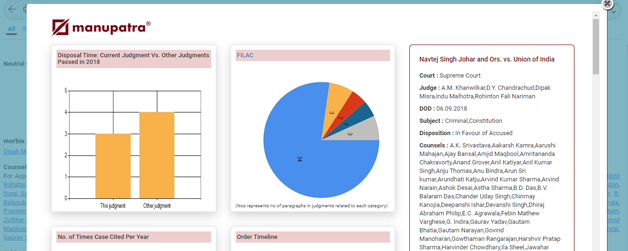FILAC – In-depth Analysis of the Judgment
Being the oldest and largest online legal research database, Manupatra always try to find out the new and effective ways to help the Lawyers, Law firms, Judiciary, Government, researchers, students and corporate in their research. In order to achieve this motive and in our efforts to make the research easier, we’ve come up with another helpful feature based on the concept of FILAC. FILAC is a complete and to the point analysis of the judgments wherein we divided the judgment in five major categories i.e. Facts, Issues, Law, Analysis and Conclusion. To make it more useful, we have also included Contentions of the parties alongwith important precedents referred and anlysed in the judgments.
Icon: 
Placed in: Judgments of the Supreme Court of India in the top right corner.
Data Covered: 24 cases till now (Manu_ids of judgments attached)
This feature provides you with a comprehensive yet crisp analysis of very long judgments in just a few pages. It’s very helpful when you don’t have the time to go through pages and pages. Please find below the detail of each category and its purpose:
Facts: Facts involves in depth analysis of all the parties of the case, events gave rise to dispute, claims made by the parties, how lower courts dealt with these claims and any other relevant information which is important to understand the base of the issues involved.
Issues: Provides details of all the issues considered by the court while disposing the case. The issue may be issue of law or the facts. This is very useful to understand the points around which the whole discussion and legal analysis revolve.
Law: Provides details of all the laws relevant for resolving and analyzing the issues involved in the case.
Analysis: Herein we provide issue-wise analysis of all the legal aspects discussed by the advocates and judges. It provides in depth information about the laws applicable, their interpretation, their relation with the issues involved and their impact of the same. Every law dealt with and declared by the judges has been analysed in this section.
Conclusion: Provides information about the final decision give by the court. It includes but not limited to guidelines issues, directions givens, references made and final outcome.
Along with above mentioned main categories, we are also providing the Contentions made by both the parties to understand the basis of the claims made; and a reference of all the relevant precedents referred and discussed in the case as a ready reckoner to the researchers, students and advocates.
Other Information available:
Along with FILAC, we have included detail judgment analysis which includes:
- Disposal Time: Current Judgment Vs. Other Judgments Passed
- No. of Times Case Cited Per Year
- Treatment In Future Cases
- Recently Cited In
- Order Timeline
- Important Para
- Case note
